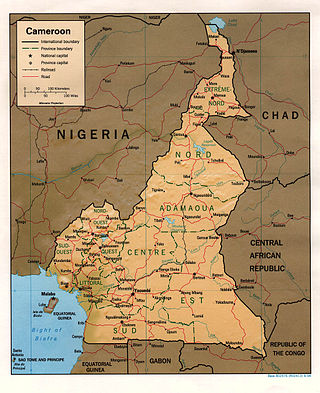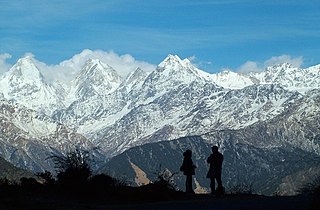Related Research Articles

At 475,440 km2 (183,570 sq mi), Cameroon is the world's 53rd largest country. It is slightly larger than the nation of Sweden and the US state of California. It is comparable in size to Papua New Guinea. Cameroon's landmass is 472,710 km2 (182,510 sq mi), with 2,730 km2 (1,050 sq mi) of water.

Gorillas are herbivorous, predominantly ground-dwelling great apes that inhabit the tropical forests of equatorial Africa. The genus Gorilla is divided into two species: the eastern gorilla and the western gorilla, and either four or five subspecies. The DNA of gorillas is highly similar to that of humans, from 95 to 99% depending on what is included, and they are the next closest living relatives to humans after chimpanzees and bonobos.

Cross River State is a state in the South-South geopolitical zone of Nigeria. Named for the Cross River, the state was formed from the eastern part of the Eastern Region on 27 May 1967. Its capital is Calabar, it borders to the north through Benue state, to the west through Ebonyi state and Abia state, and to the southwest through Akwa Ibom state, while its eastern border forms part of the national border with Cameroon. Originally known as the South-Eastern State before being renamed in 1976, Cross River state formerly included the area that is now Akwa Ibom state, which became a distinct state in 1987.

The Cross River gorilla is a critically endangered subspecies of the western gorilla. It was named a new species in 1904 by Paul Matschie, a mammalian taxonomist working at the Humboldt University Zoological Museum in Berlin, but its populations were not systematically surveyed until 1987.

Askot Musk Deer Sanctuary is located 54 km (34 mi) from Pithoragarh near Askot in Uttarakhand state of India. This sanctuary has been set up primarily with the object of conserving the musk deer (Moschus leucogaster) and its habitat. Intensive efforts have been initiated to conserve this rare species. Other mammals found in this sanctuary include the Bengal tiger, Indian leopard, Himalayan jungle cat, civet, barking deer, serow, goral and Himalayan brown bear. Many species of high altitude birds are also found in this sanctuary.

The western gorilla is a great ape found in Africa, one of two species of the hominid genus Gorilla. Large and robust with males weighing around 168 kilograms (370 lb), the species is found in a region of midwest Africa, geographically isolated from the eastern gorilla. The hair of the western species is significantly lighter in color.

The Cameroonian Highlands forests, also known as the Cameroon Highlands forests, are a montane tropical moist broadleaf forest ecoregion located on the range of mountains that runs inland from the Gulf of Guinea and forms the border between Cameroon and Nigeria. This is an area of forest and grassland which has become more populous as land is cleared for agriculture.

The wildlife of Cameroon is composed of its flora and fauna. Bordering Nigeria, it is considered one of the wettest parts of Africa and records Africa's second highest concentration of biodiversity. To preserve its wildlife, Cameroon has more than 20 protected reserves comprising national parks, zoos, forest reserves and sanctuaries. The protected areas were first created in the northern region under the colonial administration in 1932; the first two reserves established were Mozogo Gokoro Reserve and the Bénoué Reserve, which was followed by the Waza Reserve on 24 March 1934. The coverage of reserves was initially about 4 percent of the country's area, rising to 12 percent; the administration proposes to cover 30 percent of the land area.

The wildlife of Uganda is composed of its flora and fauna. Uganda has a wide variety of different habitats, including mountains, hills, tropical rainforest, woodland, freshwater lakes, swamps and savanna with scattered clumps of trees. The country has a biodiverse flora and fauna reflecting this range of habitats and is known for its primates, including gorillas and chimpanzees. There are ten national parks and thirteen wildlife reserves; some 345 species of mammal and 1020 species of bird have been recorded in the country.
Boki is a Local Government Area in the Cross River State of Nigeria. It was created on 28 August 1991, and its capital is Boje. The region has a contiguous border with the Republic of Cameroon and is known internationally as a commercial centre for agricultural commodities such as cocoa, coffee, timber, and palm products.

The Agreement on the Conservation of Gorillas and Their Habitats, also known as the Gorilla Agreement, is a multilateral environmental agreement that binds the parties to conserve gorillas in their territories. It was concluded 2007 under the auspices of the Convention on Migratory Species of Wild Animals (CMS), also known as the "Bonn Convention", with scientific support from the Royal Belgian Institute for Natural Sciences and GRASP. The Gorilla Agreement covers 10 range states and entered into force in June 2008.
Nki National Park is a national park in southeastern Cameroon, located in its East Province. The closest towns to Nki are Yokadouma, Moloundou and Lomie, beyond which are rural lands. Due to its remoteness, Nki has been described as "the last true wilderness." It has a large and varied ecosystem, and it is home to over 265 species of birds, and the forests of Cameroon contain some of the highest population density of forest elephants of any nation with an elephant density of roughly 2.5 per square kilometer for Nki and neighboring Boumba Bek National Park combined. These animals are victims of poaching, which has been a major problem since an economic depression in the 1980s. The indigenous people follow in the footsteps of the poachers, attracted by the financial opportunities. The removal of logging industries from the park, on the other hand, has been a success; it is no longer considered a major threat to Nki's wilderness.

Ape Action Africa is a non-profit NGO founded in 1996 dedicated to the conservation of endangered gorillas and chimpanzees, threatened by the bushmeat trade in Central and West Africa. Ape Action Africa manages the rescue and rehabilitation of Great apes across much of Cameroon, with a large sanctuary in the Mefou forest. Some of these Apes include the Western gorilla, Western lowland gorilla, Cross River gorilla, and the Nigeria-Cameroon chimpanzee. With more than 300 primates in its care, Ape Action Africa is now one of the largest conservation projects of its kind in Africa. Many of the animals arrive at the sanctuary as orphans, mainly due to the illegal bushmeat trade, which has grown in recent years as a result of deforestation of the Cameroonian jungle.

The Cross River National Park is a national park of Nigeria, located in Cross River State, Nigeria. There are two separate sections, Okwangwo and Oban. The park has a total area of about 4,000 km2, most of which consists of primary moist tropical rainforests in the North and Central parts, with mangrove swamps on the coastal zones. Parts of the park belong to the Guinea-Congolian region, with a closed canopy and scattered emergent trees reaching 40 or 50 meters in height.

Ise Forest Reserve is located in Ekiti State, southwestern Nigeria, covering 142 km2, 5° 20.804'E to 5° 25.331'E longitude and 7°21.069'N to 7° 25.579'N latitude in the tropical hemisphere. The protected area is about 9 km to the southern part of the reserve along the Akure-Benin expressway from the Uso community in Ondo State. It remains one of the remaining forest fragments in southwest Nigeria, militated with intense human anthropogenic activities such as farming, logging, and hunting. However, they are considered to be integral and desirable components of forest ecosystems. It is one of the priority conservation areas for the endangered Nigeria-Cameroun chimpanzees in Nigeria with a degrading forest environment. The estimated terrain elevation above sea level is 366 meters. This is the chimpanzees' primary and most frequently recorded habitat in southwest Nigeria. It is also a habitat for about 661 species of butterflies and a large community of other animals and plants. It has been in the spotlight for nearly 20 years. One of the protected sites in the tropical hemisphere is the Ise Forest Reserve. Most of the forests in Nigeria, including protected areas, are under severe fragmentation. The result is that smaller fragments have fewer numbers of animals than the single larger fragments.
The Mbe Mountains Community Forest is situated in southern Nigeria, and covers 86 km2.

The Afi River Forest Reserve is in Cross River State, Nigeria, and covers 312 square kilometres (120 sq mi). It is one of the largest forest blocks remaining in the state other than the Cross River National Park. The reserve lies between the Afi Mountain Wildlife Sanctuary and Mbe Mountains Community Forest, both of which are home to Cross River gorillas and forms a corridor between the two. A 2008 report noted that increasing levels of logging, farming and hunting were placing the gorillas under threat.
The Afi Mountain Wildlife Sanctuary in Cross River State in southern Nigeria covers 104 km2 (40 sq mi). The wildlife sanctuary was founded in 2000 to provide refuge for endangered animal species, including the Cross River gorilla, the Nigeria-Cameroon chimpanzee, the drill and the gray-necked rockfowl.

The Manyu River rises near Wabane
References
- 1 2 Wiseman, Ruth; Warren, Ymke; Nicholas, Aaron; Mackenzie, Mary; Higham, James P. (December 2008). "A GIS Habitat Map for the Kagwene Gorilla Sanctuary, Cameroon". Gorilla Journal (37). Archived from the original on 23 October 2017. Retrieved 25 May 2017.
- ↑ De Vere, Ruth; Ymke Warren; Nicholas, Aaron; MacKenzie, Mary E.; Higham, James P. (September 24, 2010). "Nest site ecology of the cross river gorilla at the Kagwene Gorilla Sanctuary, Cameroon, with special reference to anthropogenic influence". American Journal of Primatology. 73 (3): 253–261. doi:10.1002/ajp.20886. PMID 20872882. S2CID 6426172.